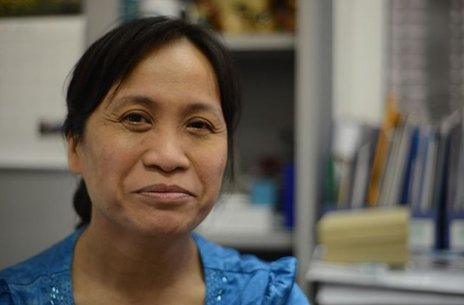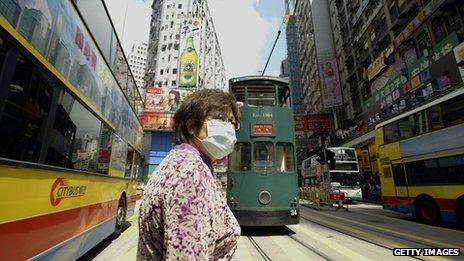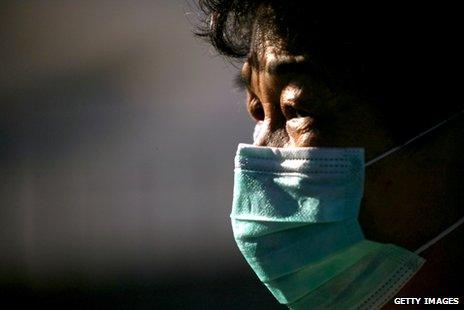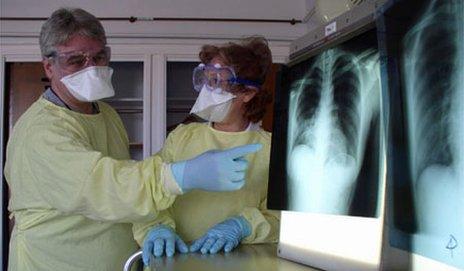Sars: The people who risked their lives to stop the virus
- Published

Ten years ago, the world was in the grip of a panic over an outbreak of a mysterious illness - Sars. The virus killed hundreds - and infected thousands more - but its impact would have been far more devastating had it not been for the bravery of a handful of doctors and nurses.
"It was like a nightmare - each morning you arrived and more people were sick."
In 2003, Dr Olivier Cattin was working at the French hospital in Hanoi, in the north of Vietnam.
"We got to the Friday and there was only one nurse left on our ward who was able to treat the other nurses, and this nurse was also sick."
One day at the end of February that year, a Chinese-American man, Johnny Chen, had arrived with what appeared to be a bad case of flu.
Within days, nearly 40 people at the hospital had fallen ill, including a number of the staff. Seven would go on to die. This was the site where the deadly disease - later named severe acute respiratory syndrome (Sars) - would come to the attention of the world.
It was highly contagious, and often deadly. More than 8,000 people around the world were infected, and more than 770 died.
But this is a story about people not statistics. The closer you get to the story of Sars, the more overwhelmed you become by the experience, and the heroism, of those who stood on the frontline.
War is a metaphor that we often use in relation to the fight against disease. But it is rarely more apt than in the case of Sars.
At the French hospital in Hanoi, panic set in as the doctors reviewed the X-rays of all those who had fallen ill. They knew they were facing something very serious and highly unusual.
"All the chest X-rays were abnormal and... were similar to Johnny Chen. We had a panic attack. We were all thinking that they were are all going to die," says Cattin.
"One by one, we saw the X-rays and there was a big silence because we could not talk… We didn't know what was going on. It was very, very scary."
The virus had a highly unusual pattern of transmission. Its peak of infectivity occurred late in the course of the disease when its victims were at their most unwell and usually in hospital care.
Because of this, the worst cases clustered in a few hospital wards and intensive care units in a handful of major cities. And within these, the virus spread like wildfire.
When Johnny Chen and some of the first medical staff to care for him all died, they began to understand what they were facing and the risk it posed to the world outside.
Full in this knowledge, they took the incredible step of locking themselves in, quarantining themselves away from the city to protect it and their country.
"I've never met such amazing doctors and nurses as I did in North Vietnam," says Cattin. "I lost five colleagues, they were friends. We're the survivors of this outbreak."
Another survivor is Dr Le Thi Quyen Mai, head of virology at the National Institute of Hygiene and Epidemiology in Hanoi.
"I am very, very lucky," she says. As news of the deadly virus spread through her institute, most of her colleagues fled, fearing for their lives. She stayed, despite having a three-year-old daughter at home.

Why? "Just a duty," she says simply.
In those early days, when events threatened to spiral out of control, perhaps their most important single asset in the fight against this outbreak was Carlo Urbani, an Italian expert on infectious diseases who was working for the World Health Organization (WHO) in Hanoi.
Urbani felt he could not stay in the office as a paper-pushing bureaucrat. As a doctor, he had to help.
It was Urbani who took samples from the patients for analysis - at great personal risk - and who first alerted the world to the crisis.
After working tirelessly in the French hospital for several weeks, he was urged to take a break. And it was then that he discovered he too had contracted Sars.
"I knew he was getting sicker and sicker," says his eldest son Tommaso Urbani, who was 15 at the time.
"But I hoped from deep down in my heart that he could make it because he was my father. And I saw him as a strong person, a strong doctor and thought he was invincible or something like that. So I never thought that he could die."
But Carlo Urbani did die, two weeks after developing the illness. Ten years on, Tommaso says he's proud of the sacrifice his father made.
"I am sure that if he could go back in time, my father would do exactly the same things. I'm happy for what he did because he saved a lot of lives."
But although the story of Sars started in Hanoi, it didn't end there.

Johnny Chen, the first patient to arrive in Vietnam suffering with the virus, was an international businessman who had arrived from abroad. And so the trail of Sars lead away from Vietnam back to its original point of explosion - Hong Kong - where Chen had stayed shortly before.
"There were two dozen of my colleagues sitting in the same room, everybody was shaking and running a high fever, many were coughing," says Prof Joseph Sung who was head of the Prince of Wales' medical faculty at the time, and was effectively the man in charge of this unfolding disaster.
"That was the beginning of the nightmare, because from that day on, every day we saw more and more people developing the same illness."
Sung divided his team into two groups. One would care for the other patients in the hospital, and the second team - the "dirty team" as they called it - would undertake the dangerous job of treating these patients, and risking infection themselves.
Anyone with young children was given an exemption from the "dirty team". But those who were single, and those whose children were grown up, were encouraged to step forward.
Not only did volunteers step forward - they kept on coming during the weeks that followed.
"I needed a continuous supply of manpower to go in. And I was very touched by the fact that after we exhausted everybody in the medical department, surgeons, orthopaedics people, gynaecologists, even ophthalmologists came to help us."
Sung himself ended up spending three months inside the hospital.

In Toronto, half a world away from the East Asian locations where Sars first arose, the virus took them completely by surprise.
At the Scarborough Grace hospital, a single patient, arriving unwell with what initially looked like a severe pneumonia, went on to infect dozens of staff.
Many were transferred to an old tuberculosis hospital on the outskirts of Toronto for quarantine and treatment.
And as in Hanoi and Hong Kong, there were those who chose to flee and those who turned up for work one day and stayed - without returning home - for weeks.
"I wrote a note to my children," says Monica Avendano, a physician and specialist in respiratory diseases at Toronto's West Park Healthcare Centre, who was one of those who decided to stay.
"I said: 'I've been exposed, I might get infected, this might kill me and if it does, don't cry too much. I did it because I'm a physician and I'm a doctor and my duty is to look after sick people.'"
Dr Avendano did survive, but the experience of Sars in Toronto was nothing if not terrifying for those involved.

Monica Avendano and a colleague at the height of the crisis in Toronto
Bruce England was a paramedic on duty in Toronto during the early days of the Sars outbreak and, having attended a patient with a chest infection, found himself falling ill.
For him, and many others affected by the Sars outbreak in Toronto, the effects of that experience are still being felt today. Ten years on Bruce still experiences weakness and difficulty with his breathing.
"I had Sars. It's left a lasting impact on me and my life. So did I survive it? Maybe not, it's still there for me," he says.
By the summer of 2003 the chain of human-to-human transmission had been broken. Doctors had come to understand when the most contagious times were for anyone infected and what precautions to take to avoid passing it on.
But what happened in Hong Kong, Vietnam and Toronto could so easily have happened in London, New York or any destination reachable by plane.
The vectors of this virus were not rats on ships but aircraft travelling at hundreds of miles an hour across the globe. The reason that this is an important story to tell and to continue to retell is because of how narrowly disaster was averted.
And I now think that the margins were much narrower than we ever realised.
Kevin Fong was reporting for a two-part BBC World Service documentary Sacrifice: The Story of Sars. Part 2 airs on Sunday at 14:06 GMT (15:06 UK time). You can also listen to part 1 and part 2 online.